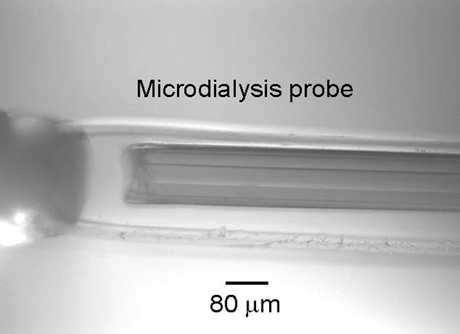The following publications are from a list of 79.
Valenta JP, Gonzales RA. Chronic intracerebroventricular infusion of monocyte chemoattractant protein – 1 leads to a persistent increase in sweetened ethanol consumption during operant self-administration but does not influence sucrose consumption in Long-Evans rats, Alcohol Clin Exp Res, 40:187-195, 2016.
Barker JM, Corbit LH, Robinson DL, Gremel CM, Gonzales RA, Chandler LJ. Corticostriatal circuitry and habitual alcohol seeking, Alcohol, in press.
Doherty, J.M. and Gonzales, R.A. Lack of effect of nucleus accumbens dopamine D1 receptor blockade on consumption during the first two days of operant self-administration of sweetened ethanol in adult Long-Evans rats, Alcohol, 49:543-51, 2015
Reno, J., Thakore, N., Gonzales, R.A., Schallert, T., Ribell, Maddox, T., Duvauchelle, C.L. Alcohol-preferring P rats emit spontaneous 22-28kHz ultrasonic vocalizations that are altered by acute and chronic alcohol experience, Alcohol Clin Exp Res, 39: 843-52, 2015
Doherty, J.M. and Gonzales, R.A. Operant self-administration of sweetened ethanol and time course of blood ethanol levels in adolescent and adult male Long-Evans rats, Alcohol Clin Exp Res, 39:485-95, 2015.
Vena, A.A. and Gonzales, R.A. Temporal Profiles Dissociate Regional Extracellular Ethanol versus Dopamine Concentrations, ACS Chem Neurosci 6: 37-47, 2015.
Mangieri, R.A., Cofresí, R.U., Gonzales, R.A. Ethanol exposure interacts with training conditions to influence behavioral adaptation to a negative instrumental contingency, Front Behav Neurosci. 8: 220. doi: 10.3389/fnbeh.2014.00220, 2014.
Valenta, J.P., Job, M.O., Mangieri, R.M., Schier, C.J., Howard, E.C., Gonzales, R.A. mu-Opioid receptors in the stimulation of mesolimbic dopamine activity in Long-Evans rats by ethanol and morphine: a delayed effect of ethanol, Psychopharmacology 228: 389-400, 2013.
Schier, C.J., Dilly, G.A., Gonzales, R.A. Intravenous Ethanol Increases Extracellular Dopamine in the Medial Prefrontal Cortex of the Long-Evans Rat, Alcohol Clin Exp Res 37: 740-7, 2013.
Schier, C J., Mangieri, R.A., Dilly, G.A., Gonzales, R.A. Microdialysis of Ethanol During Operant Ethanol Self-administration and Ethanol Determination by Gas Chromatography. J. Vis. Exp. (67), e4142, DOI: 10.3791/4142 (2012).
Mangieri, R.A., Cofresi, R.U. Gonzales, R.A. Ethanol Seeking by Long Evans Rats Is Not Always a Goal-Directed Behavior PLoS ONE 7: e42886. doi:10.1371/journal.pone.0042886, 2012
Carrillo, J. and Gonzales, R.A. A single exposure to voluntary ethanol self-administration produces adaptations in ethanol consumption and accumbal dopamine signaling, Alcohol 45: 559-566, 2011.
Ramachandra, V., Kang, F., Kim, Christine, Nova, A.S., Bajaj, A., Hall, F.S., Uhl, G.R., Gonzales, R.A. The mu opioid receptor is not involved in ethanol-stimulated dopamine release in the ventral striatum of C57BL/6J mice, Alcohol Clin Exp Res 35: 1-10, 2011
Theile, J.W., Morikawa, H., Gonzales, R.A., Morrisett, R.A. GABAergic transmission modulates ethanol excitation of ventral tegmental area dopamine neurons, Neuroscience 172: 94-103, 2011
Theile, J.W., Gonzales, R.A., Morrisett, R.A. Ethanol modulation of GABAergic inhibition in midbrain dopamine neurons: implications for the development of alcohol-seeking behaviors, in Inhibitory Synaptic Plasticity, MA Woodin, A. Maffei, eds., Springer, New York, pp 75-88, 2011.
Howard, E.C., Schier, C.J., Wetzel, J.S., Gonzales, R.A. The dopamine response in the nucleus accumbens core-shell border differs from that in the core and shell during operant ethanol self-administration, Alcohol Clin. Exp. Res. 33: 1355-1365, 2009.
Theile, J.W., Morikawa, H., Gonzales, R.A., Morrisett, R.A. Role of 5-HT2c receptors in Ca2+-dependent ethanol potentiation of GABA release onto ventral tegmental area dopamine neurons, J. Pharmacol. Exp. Ther.,329: 625-33, 2009.
Robinson, D.L., Howard, E.C., McConnell, S., Gonzales, R.A., Wightman, R.M. Disparity between tonic and phasic ethanol-induced dopamine increases in the nucleus accumbens of rats, Alcohol Clin. Exp. Res., in press.
Howard, E.C., Schier, C.J., Wetzel, J.S., Duvauchelle, C.L., Gonzales, R.A. The shell of the nucleus accumbens has a higher dopamine response compared with the core after non-contingent intravenous ethanol administration, Neuroscience 154: 1042-1053, 2008.
Theile, J., Morikawa, H., Gonzales, R.A., Morrisett, R.A. Ethanol enhances GABAergic transmission onto dopamine neurons in the ventral tegmental area of the rat, Alcohol Clin Exp Res. 32: 1040-1048, 2008.
Carrillo, J., Howard, E.C., Moten, M., Houck, B.D., Czachowski, C.L., Gonzales, R.A. A three-day exposure to 10% ethanol with 10% sucrose successfully initiates ethanol self-administration, Alcohol 42: 171-178, 2008.
Ramachandra, V., Phuc, S., Franco, A.C., Gonzales, R.A. Ethanol preference is inversely correlated with ethanol-induced dopamine release in two substrains of C57BL/6 mice, Alcohol Clin. Exp. Res. 31: 1669-76, 2007.
Job, M.J., Tang, A., Hall, F.S., Sora, I., Uhl, G.R., Bergeson, S.E., Gonzales, R.A. Mu opioid receptor regulation of ethanol-induced dopamine response in the ventral striatum: evidence of genotype specific sexual dimorphic epistasis, Biol. Psychiatry, 62: 627-34, 2007.
Zapata, A., Gonzales, R.A., Shippenberg, T.S. Repeated ethanol intoxication induces behavioral sensitization in the absence of a sensitized accumbens dopamine response in C57BL/6J and DBA/2J mice. Neuropsychopharmacology 31:396-405, 2006




